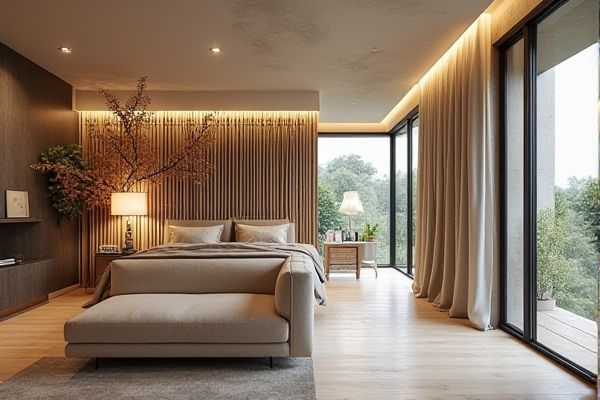
Lattice panels feature crisscrossed strips forming a grid that offers both support and decorative appeal, while slat panels consist of evenly spaced horizontal or vertical planks that enhance ventilation and privacy. Explore the rest of the article to discover which panel best suits Your outdoor or interior design needs.
Table of Comparison
| Feature | Lattice Panel | Slat Panel |
|---|---|---|
| Design | Crisscross pattern forming diamond or square shapes | Parallel, evenly spaced horizontal or vertical slats |
| Material | Wood, vinyl, metal, or composite | Wood, metal, PVC, or composite |
| Privacy | Moderate - partial visibility through gaps | Higher - adjustable gaps for controlled visibility |
| Ventilation | Good airflow due to angled openings | Excellent airflow with open slats |
| Common Uses | Garden trellises, fencing, privacy screens | Fencing, decks, shading, and decorative walls |
| Installation | Simple, requires proper alignment for symmetry | Easy installation, slats can be spaced or overlapped |
| Maintenance | Regular cleaning, occasional repainting | Low to moderate, depending on material |
| Aesthetic Appeal | Decorative, classic, traditional look | Modern, clean lines, customizable patterns |
| Cost | Moderate, varies by material and size | Varies widely, generally affordable |
Lattice Panel vs Slat Panel: An Overview
Lattice panels feature a crisscross pattern of intersecting strips, providing decorative ventilation and partial privacy ideal for garden trellises and outdoor fencing. Slat panels consist of parallel horizontal or vertical boards spaced evenly to offer a modern aesthetic with controlled light and airflow, commonly used in privacy screens and architectural facades. Both panel types enhance outdoor spaces but differ in design, ventilation, and privacy levels, making selection dependent on specific functional and stylistic requirements.
Key Design Differences between Lattice and Slat Panels
Lattice panels feature a crisscross pattern of thin strips, creating a diamond or square grid that offers partial privacy while allowing airflow and light. Slat panels consist of horizontal or vertical wood or metal strips spaced evenly to provide a modern, streamlined look with greater privacy control and shading options. Your choice depends on balancing aesthetics, ventilation, and privacy needs for your outdoor or interior space.
Material Options for Lattice and Slat Panels
Lattice panels commonly come in wood, vinyl, and composite materials, each offering varying degrees of durability and maintenance requirements. Slat panels are often made from wood, metal, or PVC, providing options for structural strength and modern aesthetics. Both types allow customization in material choice to suit different environmental conditions and design preferences.
Aesthetic Appeal: Which Suits Your Style?
Lattice panels offer intricate, crisscross patterns that evoke a classic and decorative aesthetic, ideal for traditional or cottage-style settings, while slat panels present a sleek, linear design favored in modern or minimalist spaces. The choice between lattice and slat panels depends on your personal taste and the architectural style of your home or garden. Consider lattice for a charming, ornate look or slat panels for clean lines and contemporary elegance to best complement your exterior decor.
Privacy Levels: Lattice Panel vs Slat Panel
Lattice panels provide moderate privacy by allowing partial visibility through the crisscross pattern, which balances airflow and light while obscuring direct views. Slat panels offer higher privacy levels due to their solid, closely spaced horizontal or vertical boards that block sightlines more effectively. Your choice depends on whether you prioritize a more open ambiance or greater seclusion for your outdoor space.
Installation Process and Ease
Lattice panels feature a grid-like pattern that typically allows for quicker alignment and securing during installation, often requiring fewer fasteners compared to slat panels. Slat panels involve placing each individual slat with consistent spacing, which can be more time-consuming and demands precise measurement to ensure uniformity. Both panels require basic carpentry tools, but lattice panels generally offer a more straightforward installation process for DIY enthusiasts and professionals looking for efficiency.
Durability and Maintenance Comparison
Lattice panels, constructed from crisscrossed wood or vinyl strips, offer moderate durability but may require regular maintenance to prevent weathering and warping, particularly in harsh climates. Slat panels, made from solid horizontal or vertical boards, generally provide superior durability due to their robust structure and lower surface exposure to elements, resulting in easier upkeep and less frequent repairs. To ensure your fence maintains its longevity, slat panels typically demand less routine maintenance compared to lattice panels, making them a practical choice for long-term resilience.
Cost Analysis: Lattice vs Slat Panels
Lattice panels typically cost less than slat panels due to their simpler manufacturing process and reduced material usage, making them a budget-friendly option for decorative fencing and garden structures. Slat panels, constructed from evenly spaced wooden or metal strips, tend to have higher labor and material costs, reflecting their durability and providing better privacy and structural integrity. Choosing between lattice and slat panels depends on balancing upfront costs against long-term benefits such as maintenance, aesthetics, and functional requirements.
Best Uses and Applications for Each Panel Type
Lattice panels are ideal for garden trellises, privacy screens, and decorative fencing due to their open pattern that supports climbing plants and allows airflow. Slat panels offer increased privacy and sun protection, making them suitable for modern fencing, patio enclosures, and windbreaks. Choosing between lattice and slat panels depends on balancing visibility needs with the desired level of shade and privacy in outdoor spaces.
Choosing the Right Panel for Your Project
Choosing the right panel for your project depends on factors like aesthetics, privacy, and airflow; lattice panels offer intricate patterns and better ventilation, making them ideal for garden enclosures or decorative fencing. Slat panels provide a modern, clean look with solid or spaced boards, enhancing privacy and structural strength for decks or outdoor walls. Consider your project's specific needs and the balance between style and function to select the perfect panel type for Your space.
 homyna.com
homyna.com